Start
Automatic X-Invoice Processor is the
solution for the automated processing of Factur-X files. With its
wide range of features, this powerful tool offers various ways to optimize and
streamline your e-invoicing processes. You can monitor an unlimited number of
folders to automatically print, rename, or move incoming e-invoices into
dynamically named folders. Numerous invoice data can be used to incorporate
this information into the file path or name.
The Factur-X files to be
processed can be filtered specifically for each profile using various filters,
including invoice data and general file information. Take advantage of the
numerous possibilities and let the intelligent processing of your Factur-X
files support you.
The help describes the program functions
and provides instructions for the use of Automatic X-Invoice Processor.
Main menu – menu entries of the group Menu
Options…
Use this menu item to open the dialog box
for customizing the program options.
Enter license key…
This menu entry opens the registration
dialog to enter the license key respectively to unlock the full version of the
program.
Help
Clicking on this menu item opens the online
help in the default browser. To use the online help, an active Internet
connection is required.
About…
Using this menu item, the dialog window to
display the program version of the license state will be opened. This dialog
window contains also links to contact the technical support, the product's web
page etc.
Other --> Create error report
In case of technical problems, you can
create a bug report by using this menu item. The created file is named "Automatic
X-Invoice Processor - error report" and located on the Desktop. You can
then send us the error report attached to an email with a short description of
the problem.
Other --> Clear error logs
This menu item allows the error log files
to be emptied manually. However, the program automatically removes entries that
are older than 7 days during every saving process.
Other --> Backup application data…
This menu item allows you to store the
entire application data (profiles, log, etc.) as ZIP archive in a directory to
be selected. After saving the ZIP archive is highlighted in the Explorer.
Other --> Restore application data…
This menu entry can be used to restore
previously saved application data.
Exit
Use this menu item to exit the program.
Buttons of the profile toolbar

New profile…
A click on this button opens a window for
creating a new profile.
Edit…
This button opens the window for editing
the settings of the profile that is currently selected in the list.
Duplicate
Creates a copy of the selected profile.
Catch
up…
This button allows you to apply the
selected profiles retrospectively to all E-Invoice files that meet the
respective profile-specific filter criteria. Optionally, the search process can
be limited to a certain period.
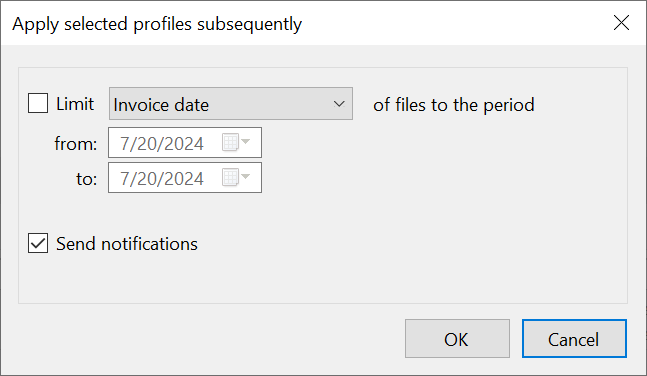
Activate
A click on this button activates the
selected entries of the profile list, i.e., the profiles get the status Active
and are applied to newly incoming PDF and XML invoices.
Deactivate
This button sets the selected profiles to
the status Inactive, i.e., the profiles are ignored when processing newly incoming
PDF and XML invoices.
Delete
By clicking the button, you can delete the
selected profiles after a confirmation prompt.
Other
Contains the following entries:
Apply all profiles subsequently…
This menu entry opens a new window in which
you can optionally specify the period of a file date. After confirmation, all ZUGFeRD
and X-Invoice files of the monitored folders will be processed subsequently
using all active profiles.
Activate all profiles
With this button, you can set all profiles
to the status Active, i.e., the profiles are applied to newly filed documents.
Deactivate all profiles
This button sets all profiles to the status
Inactive, i.e., the profiles are ignored when processing newly filed documents.
Delete all profiles
Clicking this button deletes all profiles
after a confirmation prompt.
Import profiles...
This menu item is used to import profiles
from a JSON file.
Export profiles
Here you can export profiles, for example
to transfer them to another computer. Choose from the following options:
Export all profiles
Export active profiles
Export selected profiles
Profile list
Status
Newly created profiles are given the status
Active. All profiles with this status will be applied to incoming files. To
disable a profile, click the check box at the beginning of each row. The status
then changes to Inactive.

A status change causes the profile
change date to be altered. A profile is only automatically applied to files
whose detection date lies after the profile creation date and the profile
change date.
Name
The name of the profile.
Last use (regularly)
Shows the date and time of the last
successful regular respectively automatic application of the profile.
Last use (subsequently)
Shows the date and time of the last
successful application of a profile using the Catch-Up function.
Monitored folders
A list of all folders the profile will be
applied to.
Comment
An optional comment to the profile.
Context menu of the profile list
The context menu of the profile list
contains the following entries:
Select all
Select none
Invert selection
Export profile
Profile settings
General
Name
Here you can give the profile a meaningful
name.
Comment
Optionally, you can enter a comment that
will be displayed in the profile list.
Color highlighting in the log list
Here you have the option to determine a
color in which the profile will be highlighted in the log list.
Monitored folders
Here you can add one or more folders. The
profile is applied to all added folders if the specified filter criteria are
met. When the option Including Sub-Folders is activated, additionally, all E-Invoice
files from folders which are subordinate to the added folders are processed.
Filter
Here you specify the (optional) conditions
that must be met by the file properties. Only if all filter criteria are met,
the ZUGFeRD or X-Invoice file is processed. You can use logical comparison
operators to set several conditions for a file property. In this case, the AND
operator takes precedence over the OR operator. The
filter is case insensitive - no distinction is made between uppercase and
lowercase letters of the entered terms. Wildcards as the asterisk are not
supported. Use the placeholder Regex for this. Please note that a Regex
placeholder must either be the only filter value or must be surrounded by
logical operators only. Example: <BeginOfRegex>^Invoice<EndOfRegex><AND>Company
XYZ

Example files
Specify here 5 or more PDF and/or XML files
that correspond to the ones you want to process. In the profile settings, you
will get a preview of the extracted data, verification results etc. based on
these sample files. If the E-Invoice files are only to be printed, this
specification is not necessary.
Task type: File operations (rename, move, copy …)
General settings
Here you can define whether the task is
assigned the status Activate and will therefore be executed when there are
matching PDF or XML files, or whether it is assigned the status Inactive.
Activate tasks are given a check mark in the task name.
Storage location
Folder
Select the base directory where the
attachments should be stored by clicking on the button with the label "...".
Subfolders
Use the Link Menu above the input field to
select file properties that should be used to create an optional subfolder
structure within the base directory.
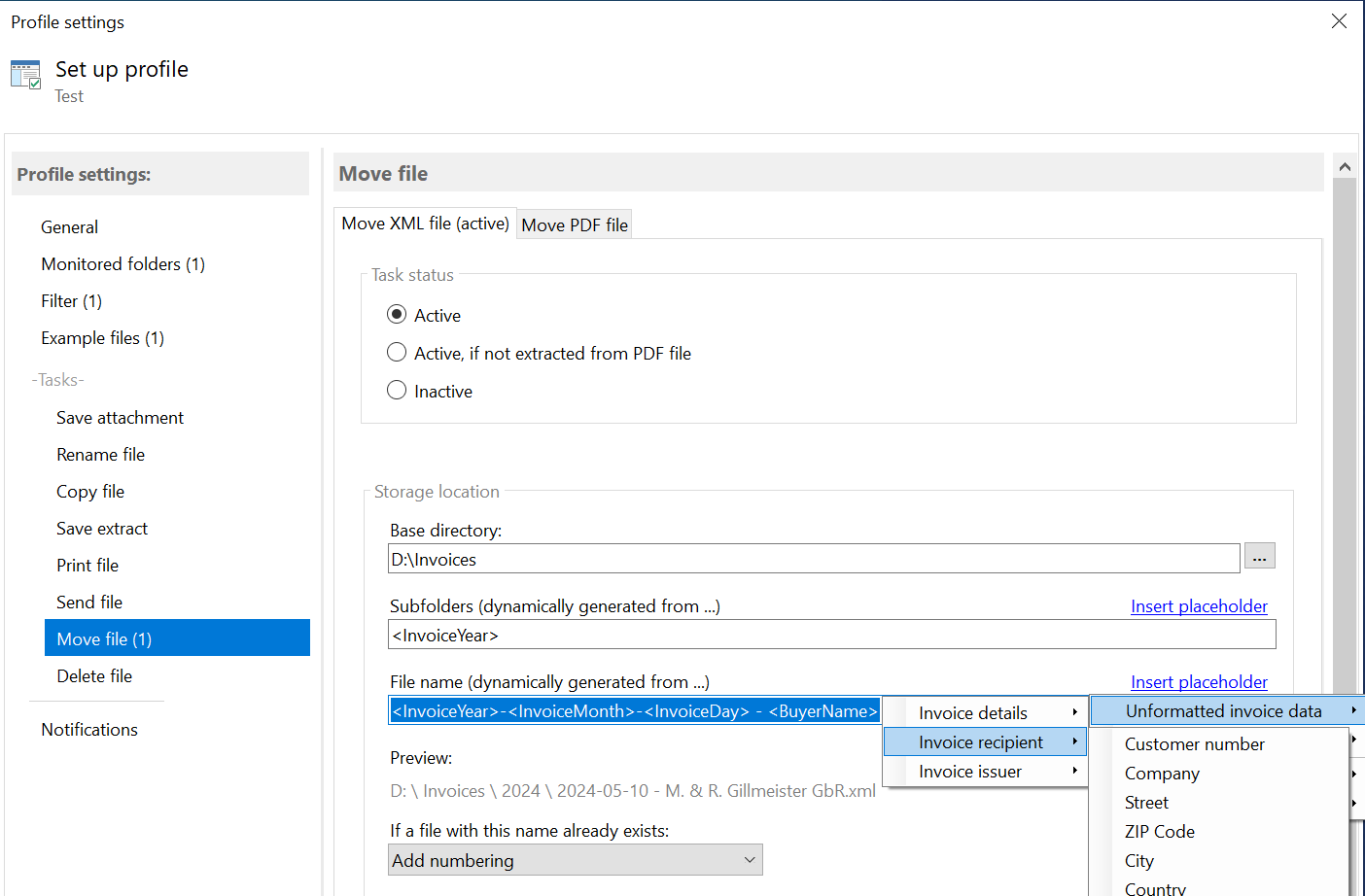
File name
Use the Link Menu above the input field to
select file properties from which the file name should be generated. If you
leave this field empty, the original name of the file is used.
Name collisions
If a file with the distinguished name
already exists, the collision rule determined here will be applied. Decide
whether the program should: overwrite the file, add a number or the processing
date to the name, or cancel the operation.
Execute program
For automatic further processing, the
path of the stored file can be passed to a program as parameter. Here, you can
optionally enter the path of a program that should be executed after storing
the file.
Parameter
Optionally enter one or more parameters
that should be passed to the program to be executed by using the link menu.
Task type: Print
General settings
Here you can define whether the task is
assigned the status Activate and will therefore be executed when there are
matching PDF or XML files, or whether it is assigned the status Inactive.
Activated tasks are given a check mark in the task name.
Print settings
Here you determine whether matching files
should be printed immediately after receipt. Activate the respective check box,
and then make the appropriate settings on the printer selection dialog. Confirm
these in the printer selection dialog by clicking the Print button.
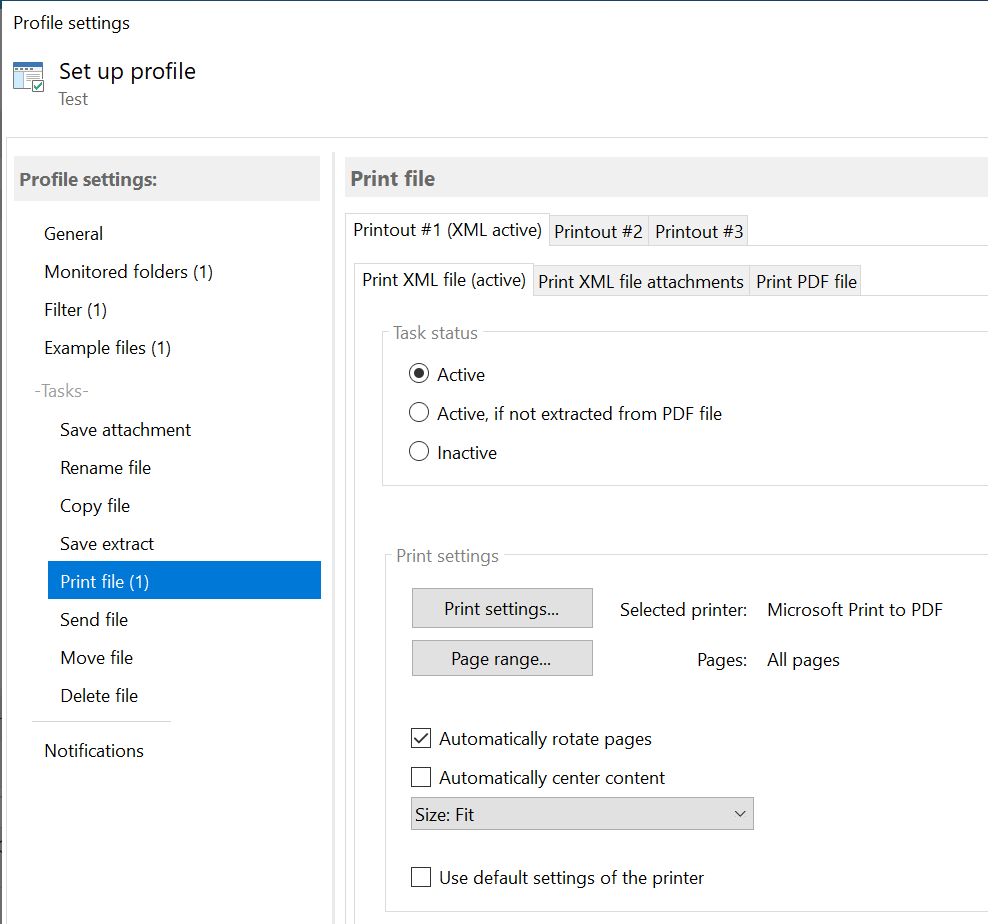
Page range
By using the Page Range dialog, you can
specify which pages to print. For example, to skip the first page, select the
type "Some pages", enter the value 2 in the field "from
page", and select "relative to beginning". In the field "To
page", enter the value 1 and select "Relative to end".
With the "Minimum number of pages of
the document", you can ensure that only documents corresponding to this
setting are printed.
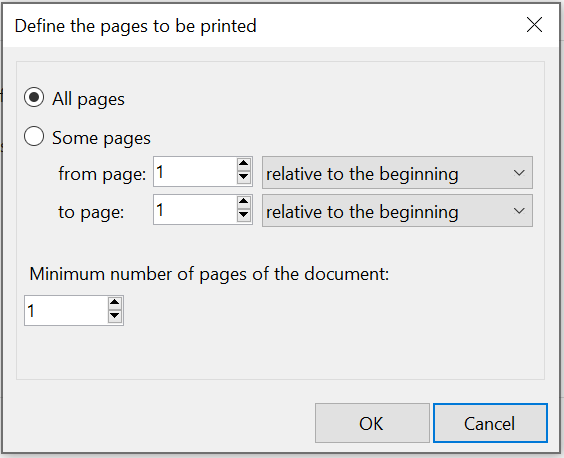
Automatically rotate pages
Determines whether the pages to be printed
should be rotated automatically. This is necessary, for example, if some
documents/pages to be processed are in portrait and some in landscape format.
The default setting is set in the program options.
Notifications
Here you can make settings that are used to
tell the processing status of a file.
Status notification via email
Select the case in which a notification is
to be made:
on success
on errors
if filter criteria are not fulfilled
and enter one or more (comma-separated)
recipients of the status message.
Status notification by an acoustic signal
Here you can optionally select a wave file
that you want to play after successful processing.
Toolbar of the log area
The toolbar contains the following buttons:

Filter log entries
By using the log filter, log entries can be
limited. The filter criteria may be, for example, the date of receipt, which is
to be limited to a period within the last week. The comparison operator is
context-sensitive, that is, he always fits the selected filter criteria. By
clicking on the button with the plus or minus symbol, further filters can be
added (linked with a logical AND) or the respective filter will be removed.
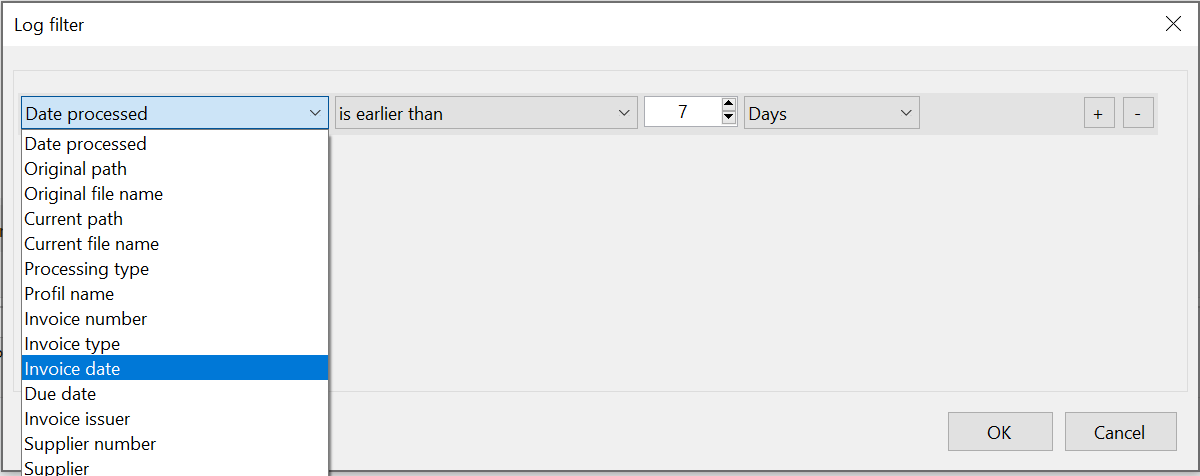
Create Excel report
This button is used to generate an overview
of the processings as an Excel report. This contains the following sheets:
Overview
Successful processing
Errors
No match
and allows filtering and custom sorting of
processing data. In the program options, you can configure a periodic sending
of the current report.
Log List
The log list contains information about all
processed files and is divided into the three tabs: "Successful processed",
"Error", "No match".
Depending on the active tab page, the context menu
contains the following entries:
Open
saved file
(opens a
saved file with the associated program)
Select saved file in Explorer
(opens the
Explorer and selects the saved file)
Copy log entry to clipboard
(copies
relevant data of the selected entry to the clipboard)
Clear list
(removes all
entries from the log list)
Status bar
Profiles
Shows the total number of profiles and the
number of active profiles.
Log
filter
Shows the number of entries that do not
fulfill the conditions of the log filter, for example, entries that are too
old.
Log entries
Shows the number of visible entries.
Status
Displays the following status information:
the number of seconds until the next check for
new files
information about the current check (the number
of files already checked)
information on current processing (the number of
files already processed)
other information about the current process
Program Options
General
Here you can define settings such as the
language of the program interface and the startup behavior as well as a
centrally managed profile file.
As soon as a centrally managed profile file
has been specified, no further changes can be made to the individual profiles -
even deletion and recreation are blocked. Changes can or should only be made by
the administrator. The administrator edits the profile file locally (i.e.,
using the application data directory "%AppData%\Automatic X-Invoice
Processor") and then copies it to the designated network folder (provided
that he does not use a centrally managed profile file himself).
The centrally managed profile file is
reloaded by the individual processes before each run and the profile list in
the main window is updated at regular intervals (every 5 minutes). Updating the
profile list in the main window can be forced by minimizing the application to
the notification area of the taskbar and then restoring it.
Processing
Interval of the check for new files to be
processed
Determines at what interval (in seconds)
"Automatic X-Invoice Processor" checks whether new files have been stored
in the monitored folders.
Pause between processing multiple new files
Here you can set whether the program should
pause for a certain time after processing a file. This option is relevant for
the further processing of saved files.
Log errors for the generation of error reports
Determines whether errors are recorded. If
problems occur, this option must be activated because detailed information
about the error is necessary to generate an error report. Otherwise, this
option can be disabled to reduce write accesses to the hard disk.
Report general errors by email
Determines whether general errors, such as
missing write permissions, are reported by email.
Move files with faulty processing to
Enables the specification of a general
directory for files that could not be processed properly and therefore must be
checked or processed manually.
Move files, which do not fulfill filter
criteria, to
Allows to specify a common directory for
files that do not meet all filter criteria.
Process files only in the following time
This option allows files to be processed
automatically only at the times specified here.
Email account for sending
Here, the email account for sending
notifications is set. You can use the default Outlook email account or provide
custom settings. The account data specified here will be used to send status
notifications to the recipients listed in the respective profile settings.
Excel report by email
This option allows you to define an
interval at which an automatically generated Excel report about the processings
of a specific period is sent to the specified email address.
Backups
If this option is enabled, the program
periodically creates a complete backup of the application data as ZIP archive
in the specified folder. The backups can be used to restore application data to
an earlier state via Menu -> Other -> Restore application data.
Print
settings
Here you can define as a default setting
whether pages to be printed should be rotated automatically. This setting can
be overwritten in the profile settings.
Other
Maximum number of entries in the log area
Defines the maximum number of entries
available in the log area. The default setting is 25,000 entries.